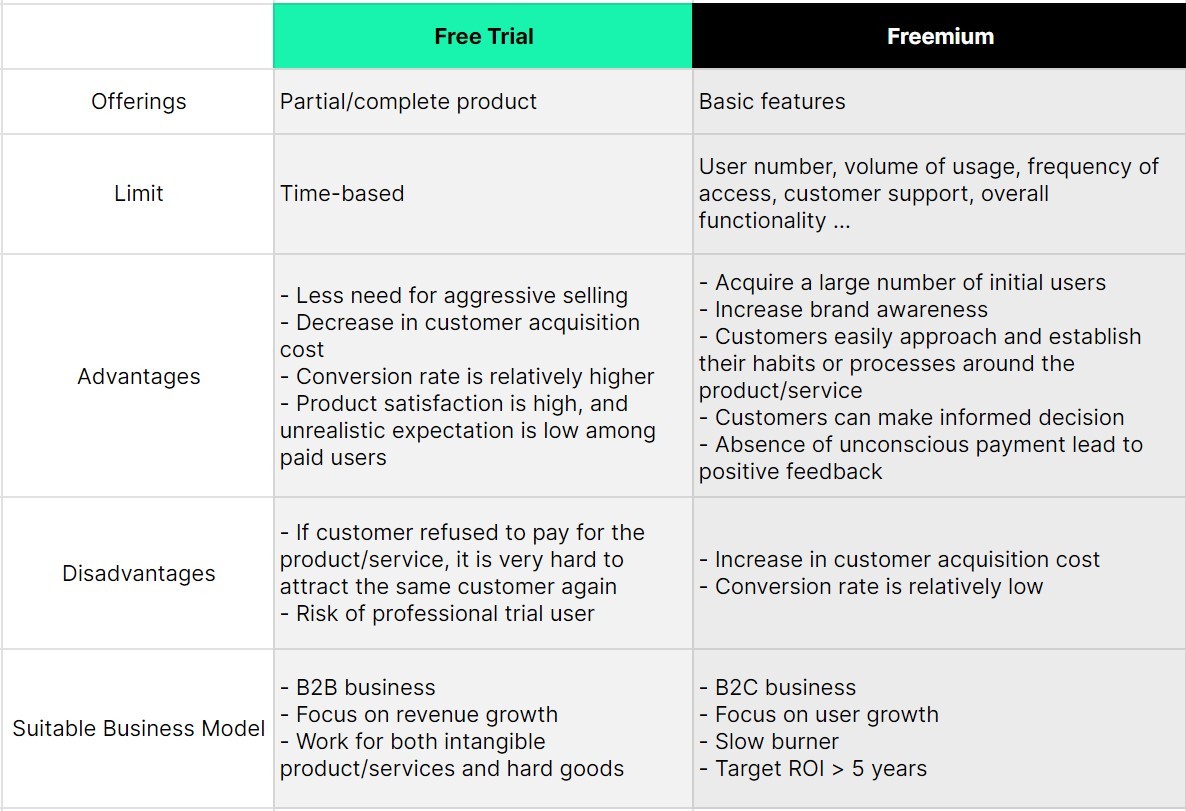Free Trial vs. Freemium
What is Free Trial?
When you provide your product/service to the customers with a time limit, it is called a ‘free trial’. The most common time limit might be a 30-days trial, but the time limit can differ from a week up to six months. Within the trial period, the customer can have access to the product/service features for free. After having a taste of the product/service, customers will finally make the decision at the end of the trial period whether to pay for it or not.
Advantages
Adopting a free trial strategy allows the product/service to sell itself, as long as the customers can explore it on their own. That is, user conversion will be driven by the product rather than sales. Less need for aggressive selling decreases the burden of the sales team so they can focus on other important tasks. Also, a free trial decreases customer acquisition costs, while the conversion rate is higher compared to the freemium strategy. Among the paying users, product satisfaction tends to appear high and unrealistic expectation is low as they already tried the product/service and know what they are using before the conversion.
💡 Note: If your product/service needs an explanation to operate or has a complex onboarding process, the conversion rate will be low.
Disadvantages
If the customer experienced a free trial and decided not to pay for the product/service, it will be very hard to attract the same customer again. The more people refuse to use the product/service, customer acquisition will be harder and more expensive. When you choose to adopt a free trial strategy, always keep in mind that the potential customer pool is not an infinite resource. Therefore, just acquiring a large number of initial customers is not important for a free trial. Target the right customers who will eventually pay for the product/service.
Be aware of professional free trial users who abuse your offer. When focusing on user acquisition, you may overlook their conversion to paying customers. If those users don't turn into paying customers, it means you are just wasting your resources and need to revisit your sales strategy. Implementing user authentication is one way to prevent abusers but what's more important is making sure your product continues to attract users after the trial.
What is Freemium?
Freemium is a combination of the term “free” and “premium”. Freemium provides basic features of subscription-based product/service to the customers without paying a cost. The biggest difference between freemium and free trial is that the limit of freemium is not based on time. The limit is different for each product/service. Some examples are user number, volume of usage, frequency of access, customer support, and overall functionality.
Do you want to adopt a freemium strategy but have no idea how much to give away for free? Then consider the 80:20 rule. Include features in a freemium plan in which 80% of the users stay unpaid, and 20% of the users pay money to upgrade.
Advantages
As the Freemium plan does not require paying, it acquires a large number of initial users. Based on that, the company can collect user information and data which can be used to make revenue from an advertisement or to improve the company’s own product/service. For startups, a freemium strategy can give an impact on increasing brand awareness while working less on customer support. From point of customers’ view, customers can easily approach and get used to the product/service, and establish their habits or processes around it. When they want to upgrade their plan, they will make fully informed decisions, and problems caused by unconscious payments will decrease. In addition, a decrease in unconscious payments leads to more positive feedback on your product/service.
Disadvantages
The biggest disadvantage of the freemium strategy is that this increases customer acquisition costs. Also, the conversion rate tends to be lower than the free trial. If the customer is satisfied with the features provided by the freemium plan, they will never upgrade to the premium plan.
What Should I Choose for My Product/Service?
Free trial
If your business is B2B or you focus on revenue growth, a free trial fits your business. Free trial is a good strategy to sell intangible product/service, but also beneficial to the sales of hard goods such as mattresses, tools, or vehicles. When you adopt a free trial for hard goods, make sure to minimize the risk of damage to the product or free-trial taker.
Freemium
Due to the absence of a time limit, it is good for a slow burner. If you are considering a long-term perspective with a target ROI(return on investment) greater than 5 years, the freemium strategy has a strong point on it. B2C business or product/service focusing on user growth are also suitable for a freemium strategy.

Free Trial & Freemium Model is just an Alternate
Adopting either free trial or freemium model as a marketing strategy is not a compulsory thing to do. Set your GTM strategy straight. Sometimes it makes more sense to not offer free trials or freemiums. Choose that fits best to your product/service and business model.
Some examples where you have to avoid offering free-anything
If you are taking a top-down marketing approach, targeting C level, directors, etc
If you need to handhold your customers to get value out of your complex product
References :
※ Legal Disclaimer
Make Equity Complete — QuotaBook is a global equity management platform with a mission to create an ecosystem for private companies and their investors and employees. Leaving spreadsheets and manual works behind, every stakeholder can connect online and sync crucial data on equity such as cap table or employee stock options. It is the leading platform used by top startups and VCs in Asia.
This piece is written for information purposes only and is not intended as financial or legal advice. QuotaBook does not assume any reliability for dependence on the information provided above.